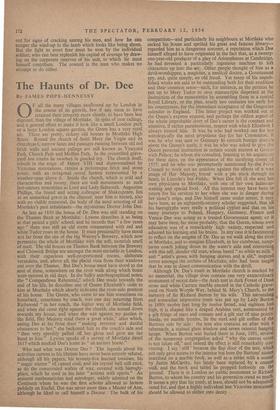The Haunts of Dr. Dee
compatriots—and particularly his neighbours at Mortlake who sacked his house and spoiled his great and famous library— regarded him as a dangerous sorcerer, a reputation which Dee himself alleged to have originated in the fact that, as a twenty- one-year-old producer of a play of Aristophanes at Cambridge, he had invented a particularly ingenious machine to loft characters up into the air. Other people thought of him as a devil-worshipper, a magician, a medical doctor, a Government spy, and, quite simply, an old fraud. Yet many of his unpub- lished works are said to be outstanding both for their erudition and their common sense—such, for instance, as the petition he put up to Mary Tudor to save manuscripts dispersed at the destruction of the monasteries by assembling them in a central Royal Library, or the plan, nearly two centuries too early for his countrymen, for the immediate acceptance of the Gregorian calendar in England. This latter project was worked out at the Queen's express request, and perhaps the oddest aspect of the whole improbable story of Dee's career is the constant and attentive, if rather parsimonious, respect with which Elizabeth I always treated him. It was he who had worked out for her astrologically the most propitious day for her Coronation; it was he who was sent to Germany to consult foreign doctors about the Queen's teeth; it was he who was asked to give the Queen personal instruction in certain occult matters at Grz.: wich Palace; he whom she consulted, listening to his argum.,:.its for three days, on the appearance 'of the terrifying comet of 1577; and he who was peremptorily summoned by.the Frvy Council to work out an antidote against the effects of a wax image of Her Majesty, found with a phi stuck through its heart, in Lincoln's Inn Fields. When Dee fell ill she sent her own physicians to Mortlake, with one of her own ladies-in- waiting and special food. All this interest may have been in return for his services to her when she was in danger during her sister's reign, and Dee himself came under arrest; it may have been, as an eighteenth-century scholar suggested, that all his hieroglyphs were really a political cypher and that on his many journeys to Poland, Hungary, Germany, France and Venice Dee was acting as a trusted Government agent; or it may have been, far more probably, that the Queen, whose own education was of a remarkably high variety, respected and admired his learning and his brains. In any case it is fascinating to reflect on the enigma of Dr. Dee as we walk along the river at Mortlake, and to imagine Elizabeth, in her cumbrous, sump- tuous coach jolting down to the water's side and conversing with this tall, slender old man, whose beard "as white as milk" and "artist's gown with hanging sleeves and a slit," inspired terror amongst the urchins of Mortlake, who had been taught that he was in direct communication with the devil.
Although Dr. Dee's tomb in Mortlake church is marked by no memorial, the village does contain one very extraordinary monument of recent date—the Arab tent in dark Forest of Dean stone and white Carrara marble erected in the Catholic grave- yard on North Worple Way, behind St. Mary's Church, to the memory of Sir Richard Burton by his wife. This astounding and somewhat impressive tomb was put up by Lady Burton in 1890; twelve feet long by twelve broad, and eighteen feet high, it is shaped like a draped Arabian tent, surmounted by a gilt fringe of stars and cressets and a gilt star of nine points. Inside, on marble trestles, lie the steel and gilt coffins of the Burtons side by side : the tent also contains an altar with a tabernacle, a stained glass window and seven oriental hanging lamps. When Burton was buried there in June, 1891, several of the numerous congregation asked "why the canvas covet is not taken off," and indeed the effect is still remarkably con. vincing. I say ' still ' because the flap door of the tent, which not only gave access to the interior but bore the Burtons' nameS, inscribed on a marble book, as well as a tablet with a sonnet by Justin McCarthy, has lately been replaced by a cement wall, and the book and tablet lie propped forlornly on the


































 Previous page
Previous page